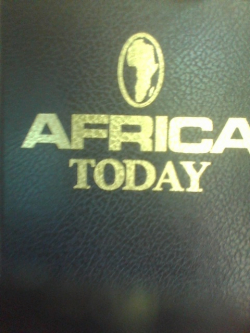Hardened Images: The Western Media and the Marginalization of Africa

Buy online ($)
Type
Book
Authors
ISBN 10
086543901X
Category
327.73 International Relations-National Security-United States
[ Browse Items ]
Publication Year
2000
Publisher
Pages
188
Subject
Press and politics -- United States -- History -- 20th century; National liberation movements -- Africa -- Foreign public opinion, American; Public opinion -- United States -- History -- 20th century; Africa -- Foreign relations -- United States; United S
Tags
Abstract
Africa, the most central of the major regions of the world, is at present languishing on the margins of the global political and economic system. The continent, which constitutes the second largest major region in the world, with a population of over 700 million, is the most neglected in the international press. The little attention that it gets in the press is generally characterized by distortion--distortion, in all its dimensions, ranging from minor omissions and commissions, to crude sensationalism, to outright and malicious misrepresentation. Africa and Africans are also the least visible and most neglected in the U.S. foreign policy making process. Washington has been less committed in Africa than in any other part of the world.
But what is the relationship between the media gatekeepers' practice of relegating Africa and Africans to near invisibility and America's policy of neglect of the continent? In Hardened Images: The Western Media and the Marginalization of Africa, Asgede Hagos, drawing on his experience as a journalist and journalism educator, examines the nature of the interplay between these two institutions--the U.S. press and the American state--on Africa, with a special focus on its armed struggles waged to complete the decolonization process.
The book is centered on three case studies--the national liberation movements of South Africa, Eritrea, and Western Sahara, which seemed to represent the last and probably the most complex and difficult stage in the decolonization of Africa. The author also takes a close look at the implication of this double-edged sword of neglect and distortion for Africa's visibility and acceptability in the world.
But what is the relationship between the media gatekeepers' practice of relegating Africa and Africans to near invisibility and America's policy of neglect of the continent? In Hardened Images: The Western Media and the Marginalization of Africa, Asgede Hagos, drawing on his experience as a journalist and journalism educator, examines the nature of the interplay between these two institutions--the U.S. press and the American state--on Africa, with a special focus on its armed struggles waged to complete the decolonization process.
The book is centered on three case studies--the national liberation movements of South Africa, Eritrea, and Western Sahara, which seemed to represent the last and probably the most complex and difficult stage in the decolonization of Africa. The author also takes a close look at the implication of this double-edged sword of neglect and distortion for Africa's visibility and acceptability in the world.
Description
Africa, the most central of the major regions of the world, is at present languishing on the margins of the global political and economic system. The continent, which constitutes the second largest major region in the world, with a population of over 700 million, is the most neglected in the international press. The little attention that it gets in the press is generally characterized by distortion--distortion, in all its dimensions, ranging from minor omissions and commissions, to crude sensationalism, to outright and malicious misrepresentation. Africa and Africans are also the least visible and most neglected in the U.S. foreign policy making process. Washington has been less committed in Africa than in any other part of the world. But what is the relationship between the media gatekeepers' practice of relegating Africa and Africans to near invisibility and America's policy of neglect of the continent? In Hardened Images: The Western Media and the Marginalization of Africa, Asgede Hagos, drawing on his experience as a journalist and journalism educator, examines the nature of the interplay between these two institutions--the U.S. press and the American state--on Africa, with a special focus on its armed struggles waged to complete the decolonization process. The book is centered on three case studies--the national liberation movements of South Africa, Eritrea, and Western Sahara, which seemed to represent the last and probably the most complex and difficult stage in the decolonization of Africa. The author also takes a close look at the implication of this double-edged sword of neglect and distortion for Africa's visibility and acceptability in the world. - from Amzon
Biblio Notes
CONTENTS
A Legacy Of Neglect …………………............................................………P. 1
United States Policy And Africa’s Struggles For Freedom Eritrea ……..P. 23
What The Records Show: The Document ………………………..........……….P. 51
What The Records Show: The Editorials ………………………………..........…P. 91
The Press And The State: A Two Dimensional Inter-Play ………………...P. 125
United States Press And Government Perspectives: 1977-1984 ……….P. 161
A Legacy Of Neglect …………………............................................………P. 1
United States Policy And Africa’s Struggles For Freedom Eritrea ……..P. 23
What The Records Show: The Document ………………………..........……….P. 51
What The Records Show: The Editorials ………………………………..........…P. 91
The Press And The State: A Two Dimensional Inter-Play ………………...P. 125
United States Press And Government Perspectives: 1977-1984 ……….P. 161
Number of Copies
1
| Library | Accession No | Call No | Copy No | Edition | Location | Availability |
|---|---|---|---|---|---|---|
| Main | 358 |
327.73 ASG |
1 | Yes |




